深入理解 Vue 组件
深入理解 Vue 组件
组件使用中的细节点
使用 is 属性,解决组件使用中的bug问题
<!DOCTYPE html>
<html lang="en"> <head>
<meta charset="UTF-8">
<meta name="viewport" content="width=device-width, initial-scale=1.0">
<meta http-equiv="X-UA-Compatible" content="ie=edge">
<title>组件使用中的细节点</title>
<script src="./vue.js"></script>
</head> <body>
<div id="root">
<table>
<tbody>
<!-- H5编码规范要求,tbody内必须是tr,因此row组件不能用,会产生bug,
因此 is 关键字起到了很好的作用,将此时的 tr 标签等于我们创建的 row 子组件。
完美解决了既要使用组件永不会影响H5编码规范的问题
不仅仅是table标签,ul ol select 标签都有相同的问题。-->
<tr is="row"></tr>
<tr is="row"></tr>
<tr is="row"></tr>
</tbody>
</table>
</div> <script>
// 创建全局子组件
Vue.component('row',{
template:"<tr><td>this is a row</td></tr>"
}) var vm = new Vue({
el:"#root", })
</script>
</body> </html>
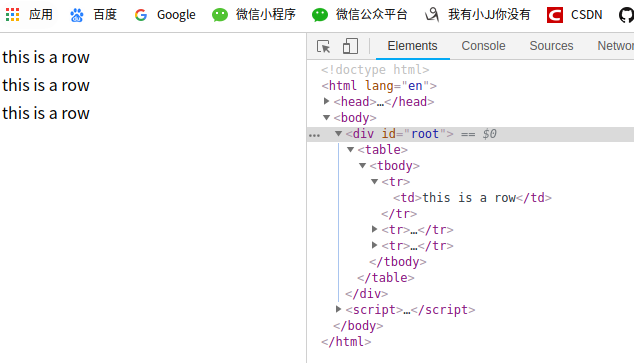
子组件定义data数据,data必须是个函数
<!DOCTYPE html>
<html lang="en"> <head>
<meta charset="UTF-8">
<meta name="viewport" content="width=device-width, initial-scale=1.0">
<meta http-equiv="X-UA-Compatible" content="ie=edge">
<title>Document</title>
<script src="./vue.js"></script>
</head> <body>
<div id="root">
<table>
<tbody>
<tr is="row"></tr>
<tr is="row"></tr>
<tr is="row"></tr>
</tbody>
</table>
</div>
<script>
// 子组件
Vue.component("row", {
// 子组件定义数据data的方法必须是一个函数返回,不能像根对象一样
data: function () {
return {
content: 'this is a row'
}
},
template: '<tr><td>{{content}}</td></tr>'
}) var vm = new Vue({
el: "#root",
})
</script>
</body> </html>

Vue中的 ref 引用的内容
<!DOCTYPE html>
<html lang="en"> <head>
<meta charset="UTF-8">
<meta name="viewport" content="width=device-width, initial-scale=1.0">
<meta http-equiv="X-UA-Compatible" content="ie=edge">
<title>ref</title>
<script src="./vue.js"></script>
</head> <body>
<div id="root">
<!-- 在vue当中,可以通过ref获取dom节点 -->
<div ref='hello' @click="handleClick">hello world</div>
</div>
<script> var vm = new Vue({
el: "#root",
methods: {
handleClick: function () {
// 获取dom中的内容
// this.$refs.hello 获取ref=hello的dom节点
alert(this.$refs.hello.innerHTML)
}
}
})
</script>
</body> </html>

vue实现计数器功能
<!DOCTYPE html>
<html lang="en"> <head>
<meta charset="UTF-8">
<meta name="viewport" content="width=device-width, initial-scale=1.0">
<meta http-equiv="X-UA-Compatible" content="ie=edge">
<title>计数器功能</title>
<script src="./vue.js"></script>
</head> <body>
<div id="root">
<counter ref='one' @change="handleChange"></counter>
<counter ref='two' @change="handleChange"></counter>
<!-- 求和 -->
<div>{{total}}</div>
</div>
<script>
// 子组件
Vue.component('counter', {
template: '<div @click="handleClick">{{number}}</div>',
data: function () {
return {
number: 0
}
},
methods: {
handleClick: function () {
this.number++
// 向外发送change事件
this.$emit('change')
}
}
}) var vm = new Vue({
el: "#root",
data: {
total: 0
},
methods: {
handleChange: function () {
this.total = this.$refs.one.number + this.$refs.two.number
// console.log(this.$refs.one.number)
// console.log(this.$refs.two.number)
}
}
})
</script>
</body> </html>

父子组件间传值
父组件向子组件传递数据
- 父组件通过属性的形式向子组件传递数据。
- 父组件可以随意的向子组件传递参数。
- 但是子组件绝对不能去修改父组件传进来的参数(单向数据流)。
<!DOCTYPE html>
<html lang="en"> <head>
<meta charset="UTF-8">
<meta name="viewport" content="width=device-width, initial-scale=1.0">
<meta http-equiv="X-UA-Compatible" content="ie=edge">
<title>父子间组件传值</title>
<script src="./vue.js"></script>
</head> <body>
<div id="root">
<!-- 父组件都是通过属性的形式向子组件传递数据 -->
<counter :count="1"></counter>
<counter :count="2"></counter>
</div> <script> // 局部组件
var counter = {
// props 表示子组件接受父组件的内容
props: ['count'],
data: function () {
return {
// 子组件自己的data number值
number:this.count
}
},
template: "<div @click='handleClick'>{{number}}</div>",
methods: {
// 点击累加方法
handleClick: function () {
// 父组件可以随意的向子组件传递参数
// 但是子组件绝对不能去修改父组件传进来的参数 单向数据流
// 因此修改自己的Number值
this.number++
},
}
} var vm = new Vue({
el: "#root",
// 注册局部组件.
components: {
counter: counter,
}
})
</script> </body> </html>
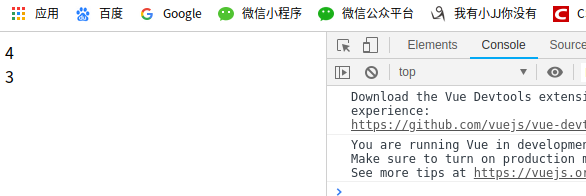
子组件向父组件传值
<!DOCTYPE html>
<html lang="en"> <head>
<meta charset="UTF-8">
<meta name="viewport" content="width=device-width, initial-scale=1.0">
<meta http-equiv="X-UA-Compatible" content="ie=edge">
<title>父子间组件传值</title>
<script src="./vue.js"></script>
</head> <body>
<div id="root">
<!-- 父组件都是通过属性的形式向子组件传递数据 -->
<counter :count="3" @change="handleChange"></counter>
<counter :count="2" @change="handleChange"></counter>
<div>{{total}}</div>
</div> <script> // 局部组件
var counter = {
// props 表示子组件接受父组件的内容
props: ['count'],
data: function () {
return {
// 子组件自己的data number值
number:this.count
}
},
template: "<div @click='handleClick'>{{number}}</div>",
methods: {
// 点击累加方法
handleClick: function () {
// 父组件可以随意的向子组件传递参数
// 但是子组件绝对不能去修改父组件传进来的参数 单向数据流
// 因此修改自己的Number值
this.number++
// 向外触发事件,后可以跟参数
this.$emit('change',1)
},
}
} var vm = new Vue({
el: "#root",
data:{
total:5,
},
// 注册局部组件.
components: {
counter: counter,
},
methods:{
handleChange:function(step){
// step = 1 步长为2
// 求和等于默认值+点击一下的步长
this.total += step
}
}
})
</script> </body> </html>

组件参数校验与非props特性
组件参数校验
组件参数校验是指:父组件向子组件传递参数的时候,子组件有权向父组件提出参数的形式和要求,并检验父组件传进的参数是否合乎要求。
<!DOCTYPE html>
<html lang="en">
<head>
<meta charset="UTF-8">
<meta name="viewport" content="width=device-width, initial-scale=1.0">
<meta http-equiv="X-UA-Compatible" content="ie=edge">
<title>组件参数校验与非props特性</title>
<script src="./vue.js"></script>
</head>
<body>
<div id="root">
<!-- <child :content="123"></child> -->
<child content="123"></child>
</div> <script> Vue.component('child',{
props:{
// content:String, // 子组件接收到的content数据,必须是一个字符串类型
// content:[Number,String] // 子组件接收到的content数据,要么是字符串,要么是数字
content:{ // 接收content
type:String, //类型type必须是string
// required:true, // 表示content必需传
// default:'default value', // 如果没有传进来,默认显示这个
validator:function(value){ // 校验器校验传入的内容长度必须大于5
return (value.length>5)
},
}
},
template:'<div>{{content}}</div>',
}) var vm = new Vue({
el:"#root", })
</script> </body>
</html>

非 Props 特性
Props 特性是指:当你的父组件使用子组件的时候通过属性向子组件传值的时候,恰好子组件里面声明了对父组件传递过来的属性的接收。
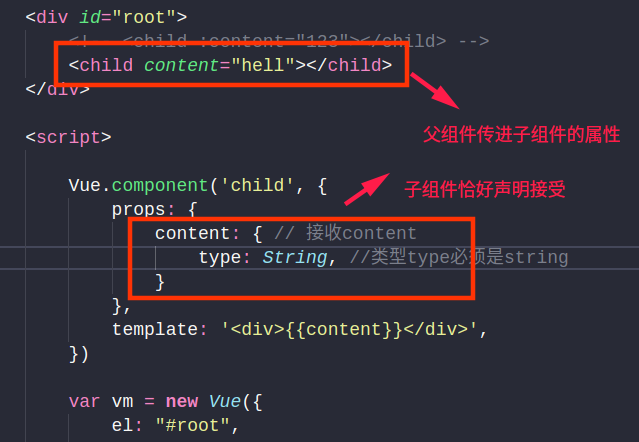
非Props 特性是指:父组件向子组件传递了一个属性,但是子组件并没有props接收的内容,也就是说,子组件并没有声明要接受父组件传递进来的属性。

非Props 特性特点一:如果子组件没人接收父组件传进的属性,则子组件不能使用父组件传进的值。
<!DOCTYPE html>
<html lang="en"> <head>
<meta charset="UTF-8">
<meta name="viewport" content="width=device-width, initial-scale=1.0">
<meta http-equiv="X-UA-Compatible" content="ie=edge">
<title>非 Props 特性</title>
<script src="./vue.js"></script>
</head> <body> <div id="root">
<!-- <child :content="123"></child> -->
<child content="hell"></child>
</div> <script> Vue.component('child', {
// props: {
// content: { // 接收content
// type: String, //类型type必须是string
// }
// }, // content 找不到,就会报错
template: '<div>{{content}}</div>',
}) var vm = new Vue({
el: "#root", })
</script>
</body> </html>

非Props 特性特点二:DOM中会保留父组件传递给子组件的属性标识
<!DOCTYPE html>
<html lang="en"> <head>
<meta charset="UTF-8">
<meta name="viewport" content="width=device-width, initial-scale=1.0">
<meta http-equiv="X-UA-Compatible" content="ie=edge">
<title>非 Props 特性</title>
<script src="./vue.js"></script>
</head> <body> <div id="root">
<!-- <child :content="123"></child> -->
<child content="hell"></child>
</div> <script> Vue.component('child', {
// props: {
// content: { // 接收content
// type: String, //类型type必须是string
// }
// },
template: '<div>hello</div>', // content 找不到,就会报错
// template: '<div>{{content}}</div>',
}) var vm = new Vue({
el: "#root", })
</script>
</body> </html>

给组件绑定原生事件
很简单,在绑定事件的click后面加一个修饰符就行。
修饰符为 .native
<!DOCTYPE html>
<html lang="en">
<head>
<meta charset="UTF-8">
<meta name="viewport" content="width=device-width, initial-scale=1.0">
<meta http-equiv="X-UA-Compatible" content="ie=edge">
<title>给组件绑定原生事件</title>
<script src="./vue.js"></script>
</head>
<body> <div id="root">
<!-- 原生点击事件 -->
<child @click.native="handleClick"></child>
</div> <script> Vue.component('child',{
template:'<div @click="handleChildClick">Child</div>',
}) var vm = new Vue({
el:"#root",
methods:{
handleClick:function(){
alert('click')
}
}
})
</script> </body>
</html>

非父子组件间的传值
情景分析
我们可以把一个网页拆分成很多个部分,每个部分就是我们代码中是我一个组件,如下面的一张图:
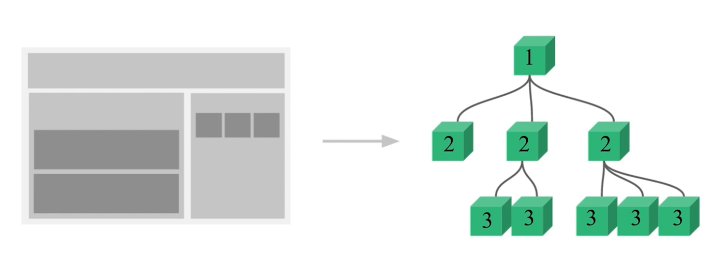
如果 1 2 层需要进行传值,则为父子组件之间的传值,通信方式在之前的内容讲到过。

如果 1 3 层进行传值,则为非父子组件间的传值,应该怎么办呢?
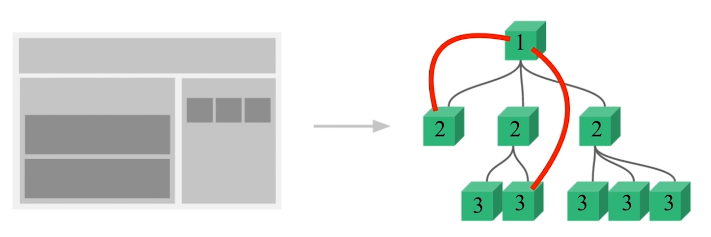
第一中方式:和父子组件间传值一样,一层一层的传递,第一层传给第二层,第二层在传给第三层,反之亦然。但是这种传值方式显然不方便太繁琐。
加入 3 3 层进行的非父子组件传值,又会是怎样的处理方法呢?

这种情况显然更加不适合层层传值,即第三层传给第二层,第二层传给第一层,第一层传给第二层,第二层传给第三层,累死了!代码变得非常的复杂。
非父子组件传值解决方法
第一种方法,我们可以使用 VUE 官方提供的一个数据层的框架,名字叫做 VUEX 来解决,但是使用有难度。
第二种方法,使用 发布订阅模式 来解决非父子组件的传值问题,在vue中叫做 总线机制 。
使用总线机制解决非父子组件传值问题
<!DOCTYPE html>
<html lang="en">
<head>
<meta charset="UTF-8">
<meta name="viewport" content="width=device-width, initial-scale=1.0">
<meta http-equiv="X-UA-Compatible" content="ie=edge">
<title>非父子组件间的传值(Bus|总线|发布订阅模式|观察者模式)</title>
<script src="./vue.js"></script>
</head>
<body>
<div id="root">
<child content="Jayvee"></child>
<child content="Wong"></child>
</div> <script> Vue.prototype.bus = new Vue() Vue.component('child',{
data:function(){
return{
selfContent:this.content
}
},
template:'<div @click="handleClick">{{selfContent}}</div>',
props:{
content:String,
},
methods:{
handleClick:function(){
this.bus.$emit('change',this.selfContent)
}
},
mounted:function(){
var this_ = this
this.bus.$on('change',function(msg){
this_.selfContent = msg
})
}
}) var vm =new Vue({
el:"#root",
})
</script> </body>
</html>

VUE 中的插槽 - slot
父组件通过传值的方式向子组件添加标签
<!DOCTYPE html>
<html lang="en">
<head>
<meta charset="UTF-8">
<meta name="viewport" content="width=device-width, initial-scale=1.0">
<meta http-equiv="X-UA-Compatible" content="ie=edge">
<title>vue中的插槽(slot)</title>
<script src="./vue.js"></script>
</head>
<body>
<div id="root">
<child content="<p>wjw</p>"></child>
</div> <script> Vue.component('child',{
props:['content'],
template:'<div><p>hello</p><div v-html="this.content"></div></div>'
}) var vm = new Vue({
el:"#root",
}) </script> </body>
</html>

使用插槽
<!DOCTYPE html>
<html lang="en">
<head>
<meta charset="UTF-8">
<meta name="viewport" content="width=device-width, initial-scale=1.0">
<meta http-equiv="X-UA-Compatible" content="ie=edge">
<title>vue中的插槽(slot)</title>
<script src="./vue.js"></script>
</head>
<body>
<div id="root">
<child>
<p>wjw</p>
</child>
</div> <script> Vue.component('child',{
template:'<div><p>hello</p><slot>默认内容</slot></div>'
}) var vm = new Vue({
el:"#root",
}) </script> </body>
</html>

传入header和footer
<!DOCTYPE html>
<html lang="en">
<head>
<meta charset="UTF-8">
<meta name="viewport" content="width=device-width, initial-scale=1.0">
<meta http-equiv="X-UA-Compatible" content="ie=edge">
<title>vue中的插槽(slot)</title>
<script src="./vue.js"></script>
</head>
<body>
<div id="root">
<body-content>
<div slot='header' class="header">header</div>
<div slot='footer' class="footer">footer</div>
</body-content>
</div> <script> Vue.component('body-content',{
template:`<div>
<slot name='header'></slot>
<div class="content">content</div>
<slot name='footer'></slot>
</div>`
}) var vm = new Vue({
el:"#root",
}) </script> </body>
</html>

Vue中的作用域插槽
<!DOCTYPE html>
<html lang="en"> <head>
<meta charset="UTF-8">
<meta name="viewport" content="width=device-width, initial-scale=1.0">
<meta http-equiv="X-UA-Compatible" content="ie=edge">
<title>vue中的作用域插槽(slot)</title>
<script src="./vue.js"></script>
</head> <body>
<div id="root">
<child>
<template slot-scope="props">
<li>{{props.item}} -- hello</li>
</template>
</child>
</div> <script>
Vue.component('child', {
data: function () {
return {
list: [1, 2, 3, 4]
}
},
template: `<div>
<ul>
<slot v-for="item of list" :item=item></slot>
</ul>
</div>`
}) var vm = new Vue({
el: "#root",
})
</script> </body> </html>

Vue的动态组件与 v-once 指令
点击按钮实现两个组件显隐切换
<!DOCTYPE html>
<html lang="en">
<head>
<meta charset="UTF-8">
<meta name="viewport" content="width=device-width, initial-scale=1.0">
<meta http-equiv="X-UA-Compatible" content="ie=edge">
<title>VUE的动态组件与v-once指令</title>
<script src="./vue.js"></script>
</head>
<body>
<div id="root">
<child-one v-if="type === 'child-one'"></child-one>
<child-two v-if="type === 'child-two'"></child-two>
<button @click="handleBtnClick">change</button>
</div> <script> Vue.component('child-one',{
template:"<div>child-one</div>"
}) Vue.component('child-two',{
template:"<div>child-two</div>"
}) var vm = new Vue({
el:'#root',
data:{
type:'child-one'
},
methods:{
handleBtnClick:function(){
this.type = this.type === 'child-one'?'child-two':'child-one'
},
}
})
</script> </body>
</html>
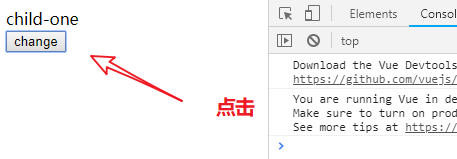
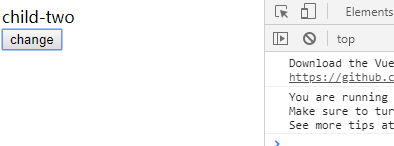
动态组件
<!DOCTYPE html>
<html lang="en">
<head>
<meta charset="UTF-8">
<meta name="viewport" content="width=device-width, initial-scale=1.0">
<meta http-equiv="X-UA-Compatible" content="ie=edge">
<title>VUE的动态组件与v-once指令</title>
<script src="./vue.js"></script>
</head>
<body>
<div id="root">
<!-- component是vue自带的,表示动态组件 -->
<component :is="type"></component>
<!-- <child-one v-if="type === 'child-one'"></child-one>
<child-two v-if="type === 'child-two'"></child-two> -->
<button @click="handleBtnClick">change</button>
</div> <script> Vue.component('child-one',{
template:"<div>child-one</div>"
}) Vue.component('child-two',{
template:"<div>child-two</div>"
}) var vm = new Vue({
el:'#root',
data:{
type:'child-one'
},
methods:{
handleBtnClick:function(){
this.type = this.type === 'child-one'?'child-two':'child-one'
},
}
})
</script> </body>
</html>

V-once 节约性能,提高静态文件的展示效率
<!DOCTYPE html>
<html lang="en">
<head>
<meta charset="UTF-8">
<meta name="viewport" content="width=device-width, initial-scale=1.0">
<meta http-equiv="X-UA-Compatible" content="ie=edge">
<title>VUE的动态组件与v-once指令</title>
<script src="./vue.js"></script>
</head>
<body>
<div id="root">
<!-- component是vue自带的,表示动态组件 -->
<!-- <component :is="type"></component> -->
<child-one v-if="type === 'child-one'"></child-one>
<child-two v-if="type === 'child-two'"></child-two>
<button @click="handleBtnClick">change</button>
</div> <script> Vue.component('child-one',{
template:"<div v-once>child-one</div>"
}) Vue.component('child-two',{
template:"<div v-once>child-two</div>"
}) var vm = new Vue({
el:'#root',
data:{
type:'child-one'
},
methods:{
handleBtnClick:function(){
this.type = this.type === 'child-one'?'child-two':'child-one'
},
}
})
</script> </body>
</html>

深入理解 Vue 组件的更多相关文章
- 不一样的角度理解Vue组件
什么是组件 以Java.C#等面向对象编程语言的角度去理解Vue组件,能够发现组件和面向对象编程的方式和风格很相似.一切事物皆为对象,通过面向对象的方式,将现实世界的事物抽象成对象,现实世界中的关系抽 ...
- 尝试用面向对象思维理解Vue组件
什么是组件 用面向对象的思维去理解Vue组件,可以将所有的事物都抽象为对象,而类或者说是组件,都具有属性和操作. 如抽取人类为组件,其基本的属性有姓名.年龄.国籍:基本的方法有吃饭.睡觉.跑步等. & ...
- 深入理解Vue组件3大核心概念
摘要: 搞懂Vue组件! 作者:浪里行舟 原文:详解vue组件三大核心概念 Fundebug经授权转载,版权归原作者所有. 前言 本文主要介绍属性.事件和插槽这三个vue基础概念.使用方法及其容易被忽 ...
- 深入理解--VUE组件中数据的存放以及为什么组件中的data必需是函数
1.组件中数据的存放 ***(重点)组件是一个单独模块的封装:这个模块有自己的HTML模板,也有data属性. 只是这个data属性必需是一个函数,而这个函数返回一个对象,这个对象里面存放着组件的数据 ...
- 怎样理解 Vue 组件中 data 必须为函数 ?
组件意在 复用 , 若为 对象, 则会相互干扰. 且 Vue 不允许此事发生, 规定必须为函数, 否则报错. 原理如下 对象 // 模拟创建组件 var Component= function() { ...
- 第四章、深入理解vue组件
4-1.使用组件的细节 a.使用is解决html出现bug 如下 table下面应该为tr,所以页面渲染的时候没有找到tr是有问题的,所以是有小bug,所以table中必须是tr b.改上面bug,t ...
- 深刻理解Vue中的组件
转载:https://segmentfault.com/a/1190000010527064 --20更新: Vue2.6已经更新了关于内容插槽和作用域插槽的API和用法,为了不误导大家,我把插槽的内 ...
- 深入理解Vue父子组件通讯的属性和事件
在html中使用元素,会有一些属性,如class,id,还可以绑定事件,自定义组件也是可以的.当在一个组件中,使用了其他自定义组件时,就会利用子组件的属性和事件来和父组件进行数据交流. 父子组件之间的 ...
- vue组件最佳实践
看了老外的一篇关于组件开发的建议(强烈建议阅读英文原版),感觉不错翻译一下加深理解. 这篇文章制定一个统一的规则来开发你的vue程序,以至于达到一下目的. 1.让开发者和开发团队更容易发现一些事情. ...
随机推荐
- 一个简单的sel server 函数的自定义
创建自定义函数:use 数据库名gocreate function 函数名(@pno int)returns intasbegin declare @a int if not exists(se ...
- phpstorm 用法
同时打开多个工程,多项目并存 File -> settings -> Directories -> Add Content Root 中添加目录 快速模板 输入fore,按下Tab, ...
- iOS 元件组件-创建静态库static library
概述 在项目开发的过程中,经常使用静态库文件.例如两个公司之间业务交流,不可能把源代码都发送给另一个公司,这时候将私密内容打包成静态库,别人只能调用接口,而不能知道其中实现的细节. 库是一些没有mai ...
- c++基础:之封装
原创: 零灵柒 C/C++的编程教室 2月4日 什么是类 C++是什么?C++设计之初就是class with c,所以简单点说,C++就是带类的C,那么什么是类? 类,简单点说就是类型,在 ...
- MyBatis基础入门《十五》ResultMap子元素(collection)
MyBatis基础入门<十五>ResultMap子元素(collection) 描述: 见<MyBatis基础入门<十四>ResultMap子元素(association ...
- 第二章 CSS基本属性
1.CSS:层叠样式表 一个元素允许同时应用多种样式,页面元素最终的样式即为多种样式的叠加效果. 2.CSS样式优先级 行内样式表>内部样式表>外部样式表[就近原则] id选择器>类 ...
- 强化学习---TRPO/DPPO/PPO/PPO2
时间线: OpenAI 发表的 Trust Region Policy Optimization, Google DeepMind 看过 OpenAI 关于 TRPO后, 2017年7月7号,抢在 O ...
- VS2010 发布网站时文件丢失解决办法
网站项目中包含了一写rdlc的东西,发布网站选择仅限运行此应用程序所需文件,发布成功后发现这两个文件夹都没发布出来,找了下原因,解决办法是选择文件打开属性窗口找到生成操作,选项选择“内容”,重新发布, ...
- SiteCore Experience Analytics-体验分析
体验分析 Sitecore Experience Analytics为营销人员和营销分析师提供仪表板和报告,以识别从其网站和可能的其他外部数据源收集的体验数据的模式和趋势. 体验分析报告示例: ...
- mysql使用navicat编写调用存储过程
在Navicat里面,找到函数,右键,新建函数,选择过程,如果有参数就填写函数,如果没有就直接点击完成 在BEGIN......END中间编写要执行的sql语句,例如下面存储过程取名为pro_data ...
